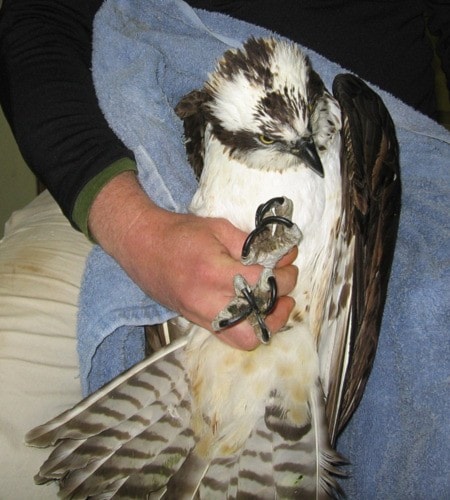Last weekend during our Walk for Wildlife we had an urgent call from an eyewitness to rescue a bird that had just "fallen from the sky."
Two bald eagles were performing their aerial acrobatics above the Courtenay ambulance station over the river when all of a sudden another bird, described as a hawk, flew in between the eagles, a move that almost turned out to be a fatal mistake.
The male eagle immediately broke contact with its mate and attacked the "hawk" slashing out with its talons and knocking the hawk out of the air onto the ground.
Quick thinking by Nigel Chapman, an eyewitness who remembered that we had our walk in progress, saved this bird's life. The rescue was captured on tape by Dean Stoltz of CHEK TV who just happened to be taping a news item about MARS at the air park.
The "hawk" turned out to be a very beautiful osprey, a bird that is rarely seen as a patient at the wildlife center in fact the last time we cared for one was in 2004. These birds are found worldwide with the exception of Antarctica, and are usually found along the shorelines of oceans, rivers and lakes.
Unique in many ways they are the sole member of a family of birds known as Pandion, and are often called "fish eagles," "sea hawks" or "fish hawks."
Ospreys do migrate in the winter mainly due to the fact that 99 per cent of their diet consists of fish which tend to swim deeper in the winter months and cannot be accessed by the birds.
On first appearance the osprey does resemble a hawk in size but once it spreads its wings a much larger bird is revealed. These raptors sport a six-foot wingspan with exceptionally long flight feathers; these feathers are different from other raptors as they are very brittle and are prone to breaking off at the tips.
The brittle feathers are a result of the stiff inflexible oil that is produced for preening, this oil is necessary for waterproofing the birds feathers as they submerge under water whilst capturing prey. Long wings give them the ability to hover over the water when zeroing in on unsuspecting prey.
Unlike any other raptor their method of hunting also makes them unique — they will plunge feet first into the water submerging their entire body before emerging out of the water.
Ospreys prefer to make their nests in very open areas, locally they can be seen on the Comox Lake, along the river and estuaries and they have adopted man made platforms in Sunnydale Golf Course. The osprey rescued by MARS sustained a deep gash in its upper chest from the eagles' talon, fortunately X-rays revealed no major organs were involved and the wound was cleaned and sutured.
Ospreys do very poorly in captivity due to their feeding habits; they will also damage their long flight feathers and struggle to keep their waterproofing. It is hoped the osprey at MARS will make a speedy recovery and will be released having learnt a hard lesson, not to tangle with eagles in the future.
• • •
Thanks again to all those who supported and sponsored the walk we raised over $2,600 for wildlife rehabilitation. To report injured or abandoned wildlife, please call 1-800-304-9968, for all other calls, 250-337-2021.
Sandy Fairfield is the educational co-ordinator for the Mountainaire Avian Rescue Society (MARS). The MARS column appears every second Friday.
